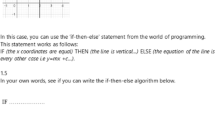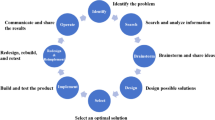Abstract
This study examined how expert and novice (preservice) teachers solved mathematical modelling tasks as well as how they noticed written artifacts of student thinking that were in response to the mathematical modelling tasks. Some teachers in both groups were aware of the openness and underdetermination of the modelling tasks and that these characteristics implied that underlying assumptions needed to be made in order to solve the tasks. Indeed, nearly all of the expert teachers addressed the need to make assumptions for the Seashell Task. When examining student work, both expert and preservice teachers interpreted positive aspects in the students’ solutions and provided feedback to students. However, almost all of the expert teachers responded by asking questions, whereas around a third of preservice teachers directly corrected students’ mistakes and another third pointed out mistakes without correcting them. This study provides a new angle to study teachers’ mathematical competencies, the assessment of modelling competencies, and considerations for the development of teachers’ modelling competencies.



Similar content being viewed by others
Notes
In this study, we use the term “preservice” rather than “novice” because other studies have identified novice teachers as student teachers and first-year teachers (e.g., Berliner, 1994). Hence, “preservice” is a more accurate descriptor for our novice teacher group.
References
Benjamini, Y., & Hochberg, Y. (1995). Controlling the false discovery rate: A practical and powerful approach to multiple testing. Journal of the Royal Statistical Society, Series B, 57, 289–300.
Berliner, D. C. (1994). Expertise: The wonders of exemplary performance. In J. N. Mangieri & C. Collins (Eds.), Creating powerful thinking in teachers and students (pp. 141–186). Holt, Rinehart and Winston.
Berliner, D. C. (2004). Expert teachers: Their characteristics, development and accomplishments. Bulletin of Science Technology Society, 24(3), 200–212.
Bliss, K. M., Galluzzo, B. J., Kavanagh, K. R., & Skufa, J. D. (2019). Incorporating mathematical modeling into the undergraduate curriculum: What the GAIMME report offers faculty. PRIMUS, 29(10), 1101–1118. https://doi.org/10.1080/10511970.2018.1488787
Blömeke, S., Gustafsson, J.-E., & Shavelson, R. (2015). Beyond dichotomies competence viewed as a continuum. Zeitschrift für Psychologie, 223, 3–13.
Blum, W., Drüke-Noe, C., Hartung, R., & Köller, O. (Eds.). (2006). Bildungsstandards Mathematik: Konkret. Sekundarstufe I: Aufgabenbeispiele, Unterrichtsanregungen, Fortbildungsideen. Cornelsen.
Borromeo Ferri, R. (2018). Learning how to teach mathematical modeling in school and teacher education. Springer.
Borromeo Ferri, R., & Blum, W. (2010). Mathematical modelling in teacher education – Experiences from a modelling seminar. In V. Durand-Guerrier, S. Soury-Lavergne, & F. Arzarello (Eds.), Proceedings of the sixth congress of the European Society for Research in Mathematics Education (pp. 2046–2055). Institut National de Recherche Pédagogique.
Brousseau, G. (1997). Theory of didactical situations in mathematics. Kluwer Academic Publishers.
Cai, J., Cirillo, M., Pelesko, J. A., Borromeo Ferri, R., Borba, M., . . . Kwon, O. (2014a). Mathematical modeling in school education: Mathematical, cognitive, curricular, instructional, and teacher education perspectives. In S. P. Liljedahl, C. O. Nicol, S. Oesterle, & D. Allan (Eds.), Proceedings of the joint meeting of the 38th International Group and the 36th North America Chapter for the Psychology of Mathematics Education (Vol. I; pp. 145–172). Vancouver, Canada: PME.
Cai, J., Ding, M., & Wang, T. (2014b). How do exemplary Chinese and U.S. mathematics teachers view instructional coherence? Educational Studies in Mathematics, 85(2), 265–280.
Carpenter, T. P., Fennema, E., & Franke, M. L. (1996). Cognitively guided instruction: A knowledge base for reform in primary mathematics instruction. The Elementary School Journal, 97(1), 3–20.
Carpenter, T. P., Fennema, E., Franke, M. L., Levi, L., & Empson, S. B. (2000). Cognitively guided instruction: A research-based teacher professional development program for elementary school mathematics. Research Report. University of Wisconsin, Madison: NCISLA, Wisconsin Center for Education Research. (ERIC Document Reproduction Services No. ED470472).
Carter, K., Cushing, K., Sabers, D., Stein, P., & Berliner, D. (1988). Expert-novice differences in perceiving and processing visual classroom information. Journal of Teacher Education, 39(3), 25–31.
Corbin, J. M., & Strauss, A. L. (2008). Basics of qualitative research: Techniques and procedures for developing grounded theory (3rd ed.). Sage.
Didis, M. G., Erbas, A. K., Cetinkaya, B., Cakiroglu, E., & Alacaci, C. (2016). Exploring prospective secondary mathematics teachers’ interpretation of student thinking through analysing students’ work in modelling. Mathematics Education Research Journal, 28(3), 349–378.
Dreher, A., & Kuntze, S. (2015). Teachers’ professional knowledge and noticing: The case of multiple representations in the mathematics classroom. Educational Studies in Mathematics, 88(1), 89–114. https://doi.org/10.1007/s10649-014-9577-8
Fisher, M. H., Thomas, J., Schack, E. O., Jong, C., & Tassel, J. (2018). Noticing numeracy now! Examining changes in preservice teachers’ noticing, knowledge, and attitudes. Mathematics Education Research Journal, 30(2), 209–232.
Galbraith, P. (2015). ‘Noticing’ in the practice of modelling as real world problem solving. In G. Kaiser & H. W. Henn (Eds.), Werner Blum und seine Beiträge zum Modellieren im Mathematikunterricht. Realitätsbezüge im Mathematikunterricht (pp. 151–166). Springer Spektrum.
Galbraith, P., Stillman, G. A., & Brown, J. P. (2017). The primacy of ‘noticing’: A key to successful modelling. In G. Stillman, W. Blum, & G. Kaiser (Eds.), Mathematical modelling and applications: International perspectives on the teaching and learning of mathematical modelling (pp. 83–94). Springer.
Gay, L. R., & Airasian, P. (2000). Educational research: Competencies for analysis and application (6th ed.). Merrill.
Jacobs, V. R., & Empson, S. B. (2016). Responding to children’s mathematical thinking in the moment: An emerging framework of teaching moves. ZDM-Mathematics Education, 48(1-2), 185–197.
Jacobs, V. R., & Spangler, D. A. (2017). Research on core practices in K-12 mathematics teaching. In J. Cai (Ed.), Compendium for research in mathematics education (pp. 766–792). National Council of Teachers of Mathematics.
Jacobs, V. R., Lamb, L. L. C., & Philipp, R. A. (2010). Professional noticing of children’s mathematical thinking. Journal for Research in Mathematics Education, 41(2), 169–202.
Jacobs, V. R., Empson, S. B., Jessup, N. A., & Baker, K. (2019). Follow-up conversations: Inside or outside of children’s strategy details? In A. Redmond-Sanogo & J. Cribbs (Eds.), Proceedings of the 46th annual meeting of the Research Council on Mathematics Learning (pp. 148–155).
Kaiser, G. (2007). Modelling and modelling competencies in school. In C. P. Haines, P. Galbraith, W. Blum, & S. Khan (Eds.), Mathematical modelling (ICTMA 12): Education, engineering and economics (pp. 110–119). Horwood.
Kaiser, G. (2017). The teaching and learning of mathematical modeling. In J. Cai (Ed.), Compendium for research in mathematics education (pp. 267–291). National Council of Teachers of Mathematics.
Kaiser, G., Schwarz, B., & Tiedemann, S. (2010). Future teacher’s professional knowledge on modeling. In R. Lesh, P. Galbraith, C. R. Haines, & A. Hurford (Eds.), Modeling students mathematical modeling competencies (pp. 433–444). Springer.
Koehler, M. S., & Grouws, D. A. (1992). Mathematics teaching practices and their effects. In D. A. Grouws (Ed.), Handbook of research on mathematics teaching and learning: A project of the National Council of Teachers of Mathematics (pp. 115–125). Macmillan.
Kuntze, S., Siller, H. S., & Vogl, C. (2013). Teachers’ self-perceptions of their pedagogical content knowledge related to modelling – An empirical study with Austrian teachers. In G. Stillman, G. Kaiser, W. Blum, & J. Brown (Eds.), Teaching mathematical modelling: Connecting to research and practice (pp. 317–326). Springer. https://doi.org/10.1007/978-94-007-6540-5_26
LaRochelle, R. (2018). Secondary teachers’ professional noticing of students’ proportional reasoning. Dissertation published by San Diego State University & University of California, San Diego, CA.
LaRochelle, R., Nickerson, S. D., Lamb, L. C., Hawthorne, C., Philipp, R. A., & Ross, D. L. (2019). Secondary practising teachers’ professional noticing of students’ mathematical thinking. Mathematics Teacher Education and Development, 21(1), 4–27.
Maaß, K. (2004). Mathematisches Modellieren im Unterricht. Franzbecker.
Maaß, K. (2006). What are modelling competencies? ZDM-Mathematics Education, 38(2), 113–142.
National Council of Teachers of Mathematics. (1989). Curriculum and evaluation standards. Author.
National Council of Teachers of Mathematics. (2000). Principles and standards for school mathematics. Author.
National Governors Association Center for Best Practices & Council of Chief State School Officers. (2010). Common Core State Standards for Mathematics. Retrieved from http://www.corestandards.org/math. Accesed 6 Jan 2021.
National Research Council. (2000). How people learn: Brain, mind, experience, and school (Exp. ed.). National Academies Press.
National Science Foundation. (n.d.). About the awards. Presidential Awards for Excellence in Mathematics and Science Teaching. Retrieved from http://paemst.org/about/view. Accessed 7 July 2020.
Niss, M., & Blum, W. (2020). The learning and teaching of mathematical modelling. Routledge.
Niss, M., & Højgaard, T. (2019). Mathematical competencies revisited. Educational Studies in Mathematics, 102(1), 9–28.
Pereira de Oliveira, A. M., & Barbosa, J. C. (2013). Mathematical modeling and the teachers’ tensions. In R. Lesh, P. Galbraith, C. Haines, & A. Hurford (Eds.), Modeling students’ mathematical modeling competencies (pp. 511–517). Springer. https://doi.org/10.1007/978-94-007-6271-8_44
Sanchez-Matamoros, G., Fernandez, C., & Llinares, S. (2014). Developing prospective teachers’ noticing of students’ understanding of the derivative concept. International Journal of Science and Mathematics Education, 13(6), 1305–1329.
Schukajlow, S., & Krug, A. (2014). Do multiple solutions matter? Prompting multiple solutions, interest, competence, and autonomy. Journal for Research in Mathematics Education, 45(4), 497–533.
Schukajlow, S., Krug, A., & Rakoczy, K. (2015). Effects of prompting multiple solutions for modelling problems on students’ performance. Educational Studies in Mathematics, 89(3), 393–417.
Schwarz, B. (2013). Professionelle Kompetenz von Mathematiklehramtsstudierenden. Springer Fachmedien.
Schwarz, B., Wissmach, B., & Kaiser, G. (2008). “Last curves not quite correct”: Diagnostic competences of future teachers with regard to modelling and graphical representations. ZDM-Mathematics Education, 40, 777–790. https://doi.org/10.1007/s11858-008-0158-0
Sherin, M. G., & van Es, E. A. (2009). Effects of video club participation on teachers’ professional vision. Journal of Teacher Education, 60(1), 20–37.
Sherin, M. G., Jacobs, V. R., & Philipp, R. A. (Eds.). (2011). Mathematics teacher noticing: Seeing through teachers’ eyes. Routledge.
Stahnke, R., Schüler, S., & Rösken-Winter, B. (2016). Teachers’ perception, interpretation, and decision-making: A systematic review of empirical mathematics education research. ZDM-Mathematics Education, 48(1), 1–27.
Stillman, G. (2011). Applying metacognitive knowledge and strategies in applications and modelling tasks at secondary school. In G. Kaiser, W. Blum, R. Borromeo Ferri, & G. Stillman (Eds.), Trends in teaching and learning of mathematical modelling (pp. 165–180). Springer.
Stillman, G., & Brown, J. P. (2011). Preservice secondary mathematics teachers’ affinity with using modelling tasks in teaching years 8–10. In G. Kaiser, W. Blum, R. B. Ferri, & G. Stillman (Eds.), Trends in teaching and learning of mathematical modelling (pp. 289–298). Springer.
Thomas, K., & Hart, J. (2013). Preservice teachers’ perceptions of model eliciting activities. In R. Lesh, P. Galbraith, C. Haines, & A. Hurford (Eds.), Modeling students’ mathematical modeling competencies (pp. 531–538). Springer. https://doi.org/10.1007/978-1-4419-0561-1_46
Walkoe, J. (2015). Exploring teacher noticing of student algebraic thinking in a video club. Journal of Mathematics Teacher Education, 18(6), 523–550.
Wendt, L., Vorhölter, K., & Kaiser, G. (2020). Teachers’ perspectives on students’ metacognitive strategies during mathematical modelling processes – A case study. In G. Stillman, G. Kaiser, & C. Lampen (Eds.), Mathematical modelling education and sense-making: International perspectives on the teaching and learning of mathematical modelling (pp. 335–346). Springer.
Wessels, H. M. (2014). Levels of mathematical creativity in model-eliciting activities. Journal of Mathematical Modelling and Application, 1(9), 22–40.
Acknowledgements
We are grateful for Denise Griffiths’s assistance with data collection, Tammy Garber’s assistance with data coding, and Victoria Robison’s assistance with copyediting.
Author information
Authors and Affiliations
Corresponding author
Additional information
Publisher’s note
Springer Nature remains neutral with regard to jurisdictional claims in published maps and institutional affiliations.
Rights and permissions
About this article
Cite this article
Cai, J., LaRochelle, R., Hwang, S. et al. Expert and preservice secondary teachers’ competencies for noticing student thinking about modelling. Educ Stud Math 109, 431–453 (2022). https://doi.org/10.1007/s10649-021-10071-y
Accepted:
Published:
Issue Date:
DOI: https://doi.org/10.1007/s10649-021-10071-y




